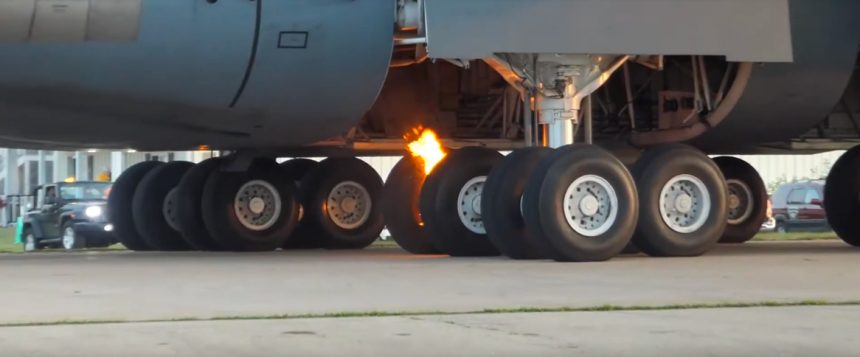A U.S. Air Force C-5M Super Galaxy experienced brake fire after landing at Oshkosh yesterday.
On Jul. 25, 2019, a C-5M Super Galaxy (example #60015) performed an evening landing at Oshkosh, Wisconsin, where the yearly EAA AirVenture Airshow is underway. The aircraft brakes started smoking after landing then a fire started after the aircraft maneuvered to vacate the runway and taxi to the apron.
As already explained, the U.S. Air Force C-5 Galaxy airlifter is equipped with a complex Main Landing Gear (MLG) made of four main units fitted in tandem pairs, each with a six-wheel bogie with two forward and four rear wheels. While the MLG is pretty unique, as the gear rotates 90 degrees horizontally to be accomodated inside the bays when retracted, the heat from the brakes can result in extreme temperatures that can cause fire associated with the tire or wheel and brake assembly, as happens to any other kind of landing gear.
Interestingly, as our reader Rod Chiapusio, Lt. Col., USAFR (Ret.), a retired C-5 pilot with 26 years of experience in the aircraft pointed out, the C-5M (and the previous C-5B, and C-5A) do not/no longer have crosswind landing gear capability. While it was initially installed in the original A models, the system was deactivated during the mid-1990’s following an incident where a pilot put the wrong crosswind correction in, resulting in the aircraft departing the paved surface. The system was never installed in the B models, and they never had “crosswind gear”.
“The rear main gear *do* unlock, and rotate 20 degrees left/right of centerline. However, the forward mains do not unlock and do not have caster capability. This unlocking is done by means of a “caster switch” on the center console, and is used strictly for taxi capability on the ground— the switch has no normal function in flight. Essentially, the aft mains are unlocked at the initiation of a turn, they freely move 20 degrees during the turn, and then are powered back to centerline when rolling out of the turn (when the caster switch is placed to the down position). In summation, the C-5 landing gear system does NOT move for crosswind landings— once down, it’s “down and locked” and functions as any normal aircraft’s landing system,” Rod explained in an email.
Indeed, an aircraft braking system works by converting the kinetic energy of a moving aircraft into heat. The heat is generated by friction between the rotating and the stationary components of the brake assemblies (as well as the friction of tyres on the runway surface): if the heat becomes excessive, a fire in the braking assembly or tyres may occur.
Should a fire develop because of “hot” brakes, cooling is usually obtained by responders using water or foam or halon cannons. As happened at Oshkosh, where fire was estinguished by an airport firefighting team.
Here’s another video, filmed from another position:
By the way, dealing with C-5s and Oshkosh, do you remember this crazy cool take off shot?









